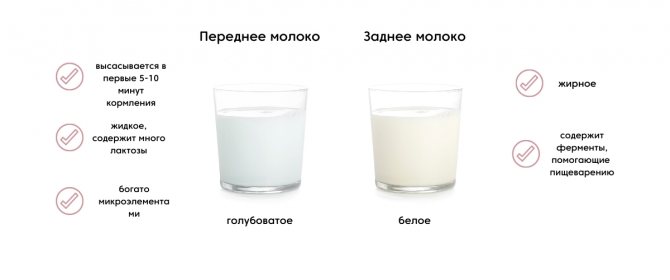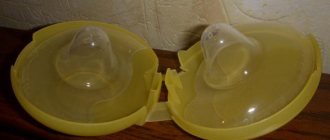23.09.2019 1733 0
Main features
False signs of low milk supply
Techniques for dealing with a lack of milk
Mother's milk is the best product for a newborn and infant. At the same time, most mothers are concerned with the question: does the baby have enough breast milk? Many mothers worry if the breasts do not fill, the baby begins to suck frequently and cry even after feeding. Let's figure out which of this is a myth and which actually indicates insufficient lactation.
Signs of a lack of breast milk
Nature intended that milk appears in all women who give birth. The problem is not enough. It happens that a newborn really does not have enough of it. There is a factor that directly affects the amount of milk produced - genetic predisposition. The amount of hormones that stimulate lactation depends entirely on heredity and is not regulated by any diets, vitamins or medications. With a high degree of probability we can say that if the grandmother did not have problems with breastfeeding, then the young mother will not have them either.
Important information! The most common reason for transferring a child to formula feeding is a lack of breast milk. There are very specific signs by which this can be reliably determined. In addition to them, there are “false” symptoms that simply mislead inexperienced mothers.
False signs of low milk supply
Such unreliable factors include the following:
- A nursing woman does not feel a rush of milk, there is no feeling of breast fullness. Such a symptom cannot indicate a milk deficiency, since a feeling of fullness is felt in the first 3-4 weeks after birth, when lactation has not yet been established. It is during this period that it feels like the breasts are literally “filling up” and it feels like there is milk, and a lot of it at once. After some time, the amount of milk produced adjusts to the baby's needs. A full breast remains soft, and the feeling of fullness occurs only if there is a long break between feedings.
- It is possible to express only a small amount of milk. Since it is impossible to check exactly how much the baby has eaten, young mothers try to pump and measure. The secret is that any breast pump, even the best, cannot replace a baby in terms of suction power. Moreover, it is impossible to do this manually.
- The baby often asks for the breast and does not let the nipple out of his mouth for a long time. Hunger is not the only reason why a child requires mother's attention. Simply being at the breast calms and calms the baby; it is a reliable place of protection and peace for him. Therefore, in case of any “trouble”: illness, malaise, fear, the baby asks to see his mother. He drinks exactly as much milk as he needs.
All these signs are unreliable signals of a lack of milk if the baby is gaining weight well and behaves calmly during feeding and during breaks.
False signs of low milk supply
Real reasons for concern
There are several signs by which you can judge possible problems with your milk supply. These are the so-called indirect or probable signs of milk deficiency :
- The child arches, restless after feeding. This behavior most likely indicates an excess of milk, which the newborn cannot yet cope with, or improper attachment. At the same time, milk remains unavailable to the baby. Anxiety after eating may be associated with an attack of colic, sudden weaning, and the baby wanted to stay longer with his mother, or painful teething.
- If a baby refuses to breastfeed, this may be a sign of a lack of milk and may be associated with a change in its taste, which is affected by the nursing mother’s consumption of spicy, salty and smoked foods.
- The child has hard, dry or green stools.
Such signs may mean that the baby does not have enough milk. In this case, it is necessary to pay special attention to the correct attachment and position of the baby’s body during feeding.
Signs that directly indicate a lack of milk
Such reliable signs include the following:
- significant weight loss;
- rare urination;
- pale skin as a sign of dehydration.
How can you really understand whether your baby is getting enough breast milk and take action in time?

Clear signs
Check weighing
To determine monthly weight gain, infants are weighed on electronic scales during regular examinations with a pediatrician. The monthly weight gain should be at least 800-900 g in the first months of life, at the age of 3-9 months it should be about 500-600 g. If there are suspicions that the child does not have enough mother’s milk for full growth, produce “control feeding” or “control weighing”. To do this, the baby is weighed before feeding, then the mother breastfeeds, and the baby is weighed again. To obtain reliable data, such weighings must be carried out several times a day, the average value must be found and the daily amount of milk consumed should be calculated from it.

Check weighing
Wet diaper test
An additional way to control the amount of milk you receive is the number of urinations per day. How to find out if your baby has enough milk - do a test and determine how many times he wets his diapers. They remove the baby's diaper, wrap it in a diaper or put on a romper, and literally “count” how many times he peed during the day. Normally, with a sufficient amount of breast milk, urination should be at least 10 times per day. This applies to children who receive only breast milk, without supplementing with water.

How to do a wet diaper test
A child does not get enough breast milk: how to determine this and what to do
How can you tell if your baby is getting enough breast milk? Why is it necessary to supplement breastfeeding with formula milk and how to properly introduce supplementary feeding? We study the “signs of a hungry baby” and find a solution to the main problems of a nursing mother - insufficient breast milk and poor weight gain of the baby - together with Alla Anatolyevna Shcherbakova, Ph.D., doctor of the highest category, pediatrician at the Mother and Child Clinic.
— Alla Anatolyevna, how can you understand that a child is not getting enough breast milk, and what are the reasons for this condition?
- A child does not get enough breast milk - this is more of a diagnosis. Parents come to see me with complaints that the baby cannot maintain the intervals between feedings, is not gaining weight well, is worried after feeding, and begins to ask for food earlier than the mother expects. And this happens not only in infants, but also in older children, 2-3 years old.
The most common reason that a child does not gain weight is insufficient nutrition. Our task is to make sure there is enough of it.
If the mother has little milk and the baby receives sufficient nutrition through artificial feeding, but still gains weight poorly, this is already a problem of impaired intestinal absorption. If such a medical diagnosis is suspected, additional examination and treatment of the child will be required.
— Please tell us about when underfeeding occurs due to lack of milk.
“The mother believes that if she breastfed the baby and the baby fell asleep, then he received enough nutrition. But the child wakes up after 30 minutes and asks to eat again. This means that he did not have enough food.
It is possible to determine that the baby has received a sufficient amount of milk from the breast only by control weighing the baby before and after feeding.
The difference between these indicators will be the volume of breast milk that he ate. You can express milk and feed it to your baby from a bottle, which also shows how much has been eaten.
And if, according to the doctor’s assessment, the child does not eat enough milk for his age and physical conditions and is not gaining weight well, he needs to be supplemented.
— Foremilk and hindmilk: why is it important to feed the baby from one breast so that he drinks and eats?
— There is an opinion that mothers have “non-nutritive” and “nutritious” milk. In fact, the composition of human breast milk is a very complex topic, it changes depending on both the time of day and the time of feeding.
Foremilk
| Hind milk
|

The baby ate the foremilk, satisfied his first hunger and fell asleep. But the baby needs to grow and develop, which means he receives carbohydrates, proteins, and fats. Therefore , it is important that during feeding the baby receives both fore and hind milk.
If the baby physically cannot suck everything, the mother needs to express.
“Non-nutritive” milk is a myth and superstition. Any breast milk is better than formula. The question is that there may not be enough milk, and then you need to take measures to improve lactation or feed with formula.
— Can supplementing with water become one of the reasons for underfeeding during breastfeeding?
— A healthy newborn and a healthy child in the first six months of life do not particularly need supplemental feeding. A baby who has just been born needs exclusively human breast milk and nothing else. After a month of life, the baby also requires a vitamin D supplement.
The child does not need to drink when the mother wants, for example, to relieve colic and abdominal pain or give the child something to drink when she thinks he is hungry. If the baby has colic, then it is a matter of colic, if he does not gain weight, then it is a matter of weight gain. If the baby asks to eat - he opens his mouth, smacks, sticks out his tongue, looks for his mother's breast, then the baby needs to be fed, and not supplemented with water.
— Alla Anatolyevna, what other signs can you name that a child is not getting enough milk?
— The main sign that a child is not eating enough is poor weight gain. All children are different, but according to WHO criteria, on average a child should gain:
- 600 g per month - in the first month of life;
- 800 g per month - up to the first 6 months;
- 400 g per month - from 6 months to 1 year.
Sometimes parents say: my child is big or my child is small, then we open centile tables - they show the average weight and height of a child of any age. If a child is less than these indicators, then his development is below average. And, most likely, the reason for this is insufficient nutrition, which cannot meet the baby’s needs for growth and development.

— How can you tell if a newborn is getting enough breast milk? And what are the signs that a baby is full and getting enough nutrition?
— The main indicator that a child has enough nutrition is weight. If he gains weight well (on average 30-50 g per day for a newborn), maintains intervals between feedings (3 hours during the day and 5 hours at night), does not ask to eat earlier, urinates at least six times a day - that means everything everything is fine, the baby is getting enough nutrition and it is being absorbed.
— Can weighing before and after feeding be uninformative and why?
— A common reason for uninformative weighing is the error of the scales. Modern scales for weighing newborns determine weight with an accuracy of up to a gram, and, in principle, it is possible to understand whether the child has received sufficient nutrition or not. If the mother weighed the baby in a diaper before feeding, then she should be weighed in the same diaper after feeding. If you weigh yourself on floor scales for adults, the error can be very high - up to 100 g.
— How to distinguish malnutrition from anxiety due to colic?
- Based on the volume of food eaten, which was calculated by the doctor.
- Colic
- Need supplementary feeding
The mother weighed the baby before and after feeding: the amount of nutrition is sufficient, but the baby is still worried (curls up his legs, blushes, cries) and does not want to eat when the mother offers the breast - this is most likely colic.
The mother weighed the child before and after feeding: there is little nutrition, but the child begins to worry 30-40 minutes after feeding, opens his mouth and asks to eat, greedily sucks on a pacifier, breast or bottle - this is most likely insufficient feeding
. In this case, we can advise the mother to pump and supplement the baby with expressed milk or offer supplementary feeding in the form of powdered milk formula. For a healthy child, a doctor can offer any dry milk formula.
— What to do if the child cries, refuses to breastfeed and remains hungry?
— More often than not, the question is not that the child refuses to breastfeed. If the mother does not have enough breast milk, and the baby asks for food and needs to be fed, what to do in such a situation? The recommendations are:
- If there is little breast milk,
care must be taken to increase lactation. The mother should rest, eat a nutritious and varied diet, stay with the child and constantly feed him on demand, first from the breast. In the first month after feeding, it is advisable to express, which also stimulates lactation. It is acceptable to replace feedings with pacifiers and nipples if the child needs to suck. - If the baby is not gaining weight well or
is not feeding enough, you need to put him to the breast more often and offer expressed breast milk. - If the mother is in the hospital
and needs to replace breast milk for a few days, it is worth using frozen breast milk or powdered milk formula. - If there is no expressed breast milk,
the baby is not gaining weight well, does not pee a lot, or cannot maintain the intervals between feedings, it is necessary to supplement him with dry milk formula. For a healthy child, this will be regular milk formulas, for example, MAMAKO® Premium formulas for comfortable digestion.
— Should you definitely try to establish breastfeeding or can you start supplementing your baby’s feeding as soon as it becomes clear that he is not getting enough to eat?
— The main recommendation for a mother who does not have breast milk is to try to establish breastfeeding
. The best food for a baby is mother's milk. 99% of the time, if a mom is committed to breastfeeding, she will breastfeed. She will make every effort for this, including pumping, drinking lactation teas, putting the baby to her breast more often, and resting.
How much nutrition does a baby need before one year of age?
Baby refuses breast milk
First of all, you need to understand what you need to strive for. How many times should a child eat and how much should he eat per day?
Indicative data on the number and volume of feedings for infants under 1 year of age
| Age, months | Daily volume, ml | Volume per feeding, ml | Number of feedings |
| Up to 1 | 600-700 | 80-100 | 7-8 |
| 1-2 | 700-900 | 100-125 | 6-7 |
| 3-4 | 900-1000 | 130-165 | 6 |
| 5-6 | 900-1000 | 170-185 | 5-6 |
| 7-9 | 1000-1100 | 190-200 | 5 |
| 9-12 | 1000-1200 | 200-245 | 4-5 |
These data are averaged; you need to focus on the child himself, his well-being and condition.
How to tell if your baby has enough milk
The question of how to understand that a child is not getting enough breast milk worries all mothers.
Since milk replaces water for the baby, if there is a lack of it, symptoms of dehydration may appear:
- The child wakes up frequently.
- Eyeballs are sunken.
- The tongue and lips become dry, and the saliva becomes thick.
- “Tearless” crying.
- Dry, flabby skin.
- He urinates less than 6 times a day, and the urine has a strong smell and is dark in color.
- There is an unpleasant odor when breathing.
If a child has at least 2 of the listed signs, he needs emergency care, which involves the administration of intravenous fluid.
Dehydration can be prevented by closely monitoring your baby and being aware of the signs of malnutrition in infants.

Crying without tears in a child is a symptom of dehydration.
Ways to increase lactation
If milk deficiency really exists, the child is not gaining weight, it is necessary to try to increase lactation. The transition to artificial nutrition should be left as a last resort, when there is no other option.
5 ways to determine the fat content of breast milk
The baby may not receive enough milk for the following reasons:
- incorrect application technique;
- the baby's health status;
- physical health status of the nursing mother;
- incorrect feeding regimen;
- psychological crisis in the mother.
For proper feeding, the baby must be properly applied to the breast: the baby should be in a position where not only the head, but the whole body is turned towards the mother. In this position, sucking will be comfortable, and feeding will be complete. The baby should also grasp the lower part of the areola with his mouth, the body should be pressed against the mother, skin-to-skin contact is very important. During the feeding period, the baby must be supported not only by the shoulders, but also by the buttocks so that he does not “slip.” While eating, there should be no smacking sounds; the child should suck and swallow milk.
Important information! To develop the correct technique for breastfeeding during a crisis, bottles with nipples should be completely eliminated and it is advisable to remove pacifiers. Otherwise, the baby will continue to “draw” the milk incorrectly, as if through a straw.
It is necessary to start feeding the baby in the maternity hospital, immediately after birth. The first hours are very important to start the milk production mechanism. Despite the fact that the first “full” milk usually comes on the 3rd day after birth, the baby must be applied to the breast in the delivery room. Postponing feeding for the period of recovery and rest, which is still practiced in some institutions, leads to a later development of lactation or its disruption.

Feeding immediately after birth
Feeding on demand
A highly effective technique for increasing lactation is the “on demand” feeding technique. It is through frequent latching and irritation of the nipple during feeding that milk production is naturally stimulated. This is especially effective in the first two months of a child’s life, when, due to inept actions or uncertainty of the nursing mother, a lactation crisis can occur - a temporary decrease in the amount of milk.
Feeding on demand necessarily includes night feeding. It is at night that a special hormone is produced that is responsible for lactation. To successfully implement such a technique, it is necessary to ensure a comfortable state for the nursing mother. Adequate sleep, a varied diet and the opportunity to rest are really necessary components of psychological health. The last thing a mother needs is total control and strict instructions on exactly how to behave during feeding.
The baby and mother need to relax and try to find the optimal solution for both of them in what mode and certain position to feed. The on-demand feeding technique involves close contact with the baby; the breast is not only a means of feeding, but also comfort and communication. If the baby is dissatisfied or sniffles, the mother’s breast is given. The more often this happens, the better.
Important information! You should not go to extremes - breastfeeding up to 30 times a day practically eliminates the possibility of going outside. In addition, the risk of cracked nipples increases significantly.
Should I feed both breasts at one feeding?
Pediatricians recommend feeding from only one breast during one feeding and alternating them. This should only be considered as a recommendation and in no way a law. There may be cases when little milk is produced in one breast, which is caused by physiological features of the structure, or the nipples become cracked during improper feeding.
If it is clear that the baby has already “drained” one breast, and there really is no more milk there, but the baby himself is still looking for and asking for additional food, be sure to give the second one. After finishing feeding, you need to express the remaining milk from it so that it becomes as empty as the first one. If there is still objectively little milk, and both breasts are required for full feeding, which as a result remain empty, then it is necessary to use all “sources” of food.

Feeding from all possible sources
If there is not enough milk, then after each feeding it is necessary to replenish the amount of fluid in the mother’s body. To do this, you can take special medications based on nicotinic and glutamic acids that increase lactation. You can get by with home remedies: tea with milk, dried fruit compote, juices.
Important to remember! It is healthy sleep and proper rest that contribute more to milk production than all medications combined.

Medications
To maintain and increase lactation, a psychological attitude is very important. You should not look for illnesses and deficiencies in mother and child. The best solution would be to continue feeding your baby breast milk rather than supplementing or completely switching to formula feeding.
Proper organization of feeding
Application on demand
The baby's sucking reflex exists not only for food, it appears due to the physiological characteristics of the little miracle. To strengthen the cheeks, lips and mouth, it is necessary to attach the baby to the breast. Otherwise, in the future he may start sucking his fist. Be sure to put the baby to the breast upon request.

Frequency and duration of feedings
A newborn requires the breast for good sleep and comfort. You need to eat as much as you want. When the nipple is stimulated by the baby's mouth, the amount of milk that is needed appears. This is a natural reaction of the female body when breastfeeding.
It is important to properly attach the baby to the breast and ensure correct latching during feeding. The position is chosen to be comfortable for both, the nipple should be grasped together with the areola, the baby’s lower lip should be slightly turned out, the mouth should be wide open, and the mother should be relaxed. The baby should suck, not chew. There are special pillows that ease the load on the mother's back when feeding.
If your newborn sleeps a lot, you need to wake him up for feedings. During the day he should sleep no more than three hours, at night no more than five.
Mom should eat rationally, get enough sleep, rest and drink more fluids. Eating a variety of foods with a balance of proteins, fats, and carbohydrates improves the quality of milk. It is important to eat lean fish and boiled meat, eggs, vegetables, fruits, cereals, kefir, dairy products, and cheese. There are herbal teas with fennel, anise, and cumin to improve the flow of nutrient fluids.
There is no need to try to wean your baby off the breast prematurely. The longer the baby eats milk, the stronger his body will be in the future.
The newborn's nutrition must be monitored. The future health and development of the baby depends on its quality and quantity. It is important for newborns to get enough milk .
List of harmful advice that is not recommended to be followed:
- Some nursing mothers advise weighing the baby before/after feeding. The procedure will be biased in determining the level of saturation. It is necessary to weigh the baby once a week or month.
- You should do without supplementary feeding with formulas. The more often the mother feeds them, the less milk will come to the breast. Accordingly, the newborn will switch to artificial food earlier.
- You need to give up cow's milk for complementary feeding. A child’s body at this age is not prepared for such a product.
- In order not to provoke the gastrointestinal tract of the newborn, you should not introduce complementary foods until six months.
- Milk is 85% water, which is enough to saturate a small body with fluid.
- A mother's milk is produced from her blood. There is no need to increase the mother's intake of cow's or goat's milk.











